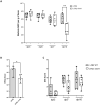An adherent-invasive Escherichia coli-colonized mouse model to evaluate microbiota-targeting strategies in Crohn's disease
- PMID: 36172858
- PMCID: PMC9637268
- DOI: 10.1242/dmm.049707
An adherent-invasive Escherichia coli-colonized mouse model to evaluate microbiota-targeting strategies in Crohn's disease
Abstract
Adherent-invasive Escherichia coli (AIEC) were investigated for their involvement in the induction/chronicity of intestinal inflammation in Crohn's disease (CD). AIEC gut establishment is favoured by overexpression of the glycoprotein CEACAM6 in the ileal epithelium. We generated a transgenic mouse model, named 'Vill-hCC6', in which the human CEACAM6 gene was under the control of the villin promoter, conditioning expression in the small intestine. We demonstrated that CEACAM6 is strongly expressed in the small intestine mucosa and is correlated with numerous glycosylations displayed at the brush border of enterocytes. Ex vivo, the AIEC-enterocyte interaction was enhanced by CEACAM6 expression and necessitated the presence of the bacterial adhesive factor FimH. Finally, AIEC bacteria preferentially persisted in a FimH-dependent manner in the ileal mucosa of Vill-hCC6 mice compared to wild-type mice. This preclinical model opens new perspectives in the mechanistic study of the AIEC pathobiont and represents a valuable tool to evaluate the efficacy of new strategies to eliminate AIEC implanted in the ileal mucosa, such as phages, inhibitory and/or anti-virulence molecules, or CRISPR-based strategies targeting virulence or fitness factors of AIEC bacteria.
Keywords: AIEC; CEACAM6; Crohn's disease; Ileal colonization; Mouse model.
© 2022. Published by The Company of Biologists Ltd.
Conflict of interest statement
Competing interests The authors declare no competing or financial interests.
Figures







References
-
- Barnich, N., Carvalho, F. A., Glasser, A.-L., Darcha, C., Jantscheff, P., Allez, M., Peeters, H., Bommelaer, G., Desreumaux, P., Colombel, J.-F.et al. (2007). CEACAM6 acts as a receptor for adherent-invasive E. coli, supporting ileal mucosa colonization in Crohn disease. J. Clin. Invest. 117, 1566-1574. 10.1172/JCI30504 - DOI - PMC - PubMed
-
- Bretin, A., Lucas, C., Larabi, A., Dalmasso, G., Billard, E., Barnich, N., Bonnet, R. and Nguyen, H. T. T. (2018). AIEC infection triggers modification of gut microbiota composition in genetically predisposed mice, contributing to intestinal inflammation. Sci. Rep. 8, 12301. 10.1038/s41598-018-30055-y - DOI - PMC - PubMed
-
- Buisson, A., Vazeille, E., Fumery, M., Pariente, B., Nancey, S., Seksik, P., Peyrin-Biroulet, L., Allez, M., Ballet, N., Filippi, J.et al. (2021). Faster and less invasive tools to identify patients with ileal colonization by adherent-invasive E. coli in Crohn's disease. United European Gastroenterol. J. 9, 1007-1018. 10.1002/ueg2.12161 - DOI - PMC - PubMed
Publication types
MeSH terms
LinkOut - more resources
Full Text Sources
Medical
Molecular Biology Databases

